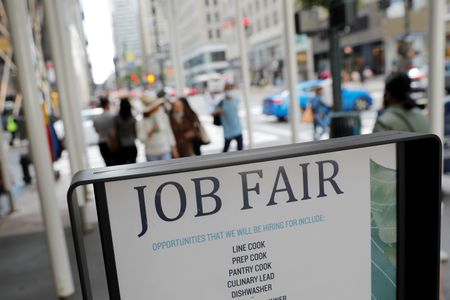By Lucia Mutikani
WASHINGTON (Reuters) -The number of Americans filing new claims for unemployment benefits unexpectedly fell last week, suggesting the labor market remains strong despite slowing domestic demand amid stiff interest rate hikes from the Federal Reserve to tame inflation.
The weekly unemployment claims report from the Labor Department on Thursday, the most timely data on the economy’s health, followed on the heels of news this week of an unexpected jump in job openings in September. Labor market resilience gives the Fed cover to continue tightening monetary policy, and also keeps the economy growing for now.
“There is still no indication that layoffs are picking up in any meaningful way,” said Dante DeAntonio, senior economist at Moody’s Analytics in West Chester, Pennsylvania. “The ongoing lack of layoffs will help propel consumer spending moving forward even as household balance sheets come under pressure from high inflation.”
Initial claims for state unemployment benefits slipped 1,000 to a seasonally adjusted 217,000 for the week ended Oct. 29. Data for the prior week was revised to show 1,000 more applications filed than previously reported. Economists polled by Reuters had forecast 220,000 claims for the latest week.
Unadjusted claims rose 1,174 to 185,594 last week. They were lifted by a 2,535 jump in filings in California as a well as a increase of 1,566 in Oregon, which offset a 1,832 drop in Florida as the effects on Hurricane Ian faded. There was also a notable decline in claims in Kentucky.
Claims bounced around in a tight 214,000 to 226,000 range in October. Though there has been an increase in layoffs in interest rate-sensitive sectors of the economy like finance, technology and housing, employers have generally been hoarding workers as labor remains scarce in some service industries.
The U.S. central bank on Wednesday raised interest rates by another 75 basis points and said its fight against inflation would require borrowing costs to rise further, but signaled it may be nearing an inflection point in what has become the swiftest tightening of U.S. monetary policy in 40 years.
Fed Chair Jerome Powell told reporters that the labor market “remains extremely tight,” and “continues to be out of balance.”
There were 1.9 job openings for every unemployed person at the end of September, which is boosting wage growth.
U.S. stocks opened lower. The dollar rallied against a basket of currencies. U.S. Treasury prices fell.
UPTICK IN LAYOFFS
The claims report also showed the number of people receiving benefits after an initial week of aid, a proxy for hiring, rose 47,000 to 1.485 million in the week ending Oct. 22. The data has no bearing on October’s employment report, scheduled to be released on Friday, as it falls outside the survey period.
According to a Reuters survey of economists, nonfarm payrolls likely increased by 200,000 jobs in October. The economy created 263,000 jobs in September.
Domestic demand barely grew in the third quarter even as gross domestic product rebounded after contracting in the first half of the year, largely driven by a shrinking trade deficit.
Though unemployment rolls remain small, there has been an uptick in layoffs. A separate report from global outplacement firm Challenger, Gray & Christmas on Thursday showed job cuts announced by U.S.-based employers increased 13% to 33,843 in October, the highest since February 2021.
There was a jump in planned layoffs in construction, technology, industrial goods and warehousing industries.
“We are beginning to see more job cut activity in the fourth quarter, historically when the bulk of cuts occur, as companies finalize budgets and plans,” said Andrew Challenger, senior vice president at Challenger, Gray & Christmas.
Still, announced layoffs so far this year are down 16% to
243,338, the lowest January-October total since Challenger began tracking the series in 1993. Employers announced plans to hire 237,380 workers last month compared to 380,014 in September.
Wage pressures could remain elevated for a while, with worker productivity barely growing. A third report from the Labor Department showed nonfarm productivity, which measures hourly output per worker, rose at a 0.3 annualized rate in the third quarter after slumping at a 4.1% pace in the second quarter. Productivity fell at a 1.4% rate from a year ago.
As a result, unit labor costs – the price of labor per single unit of output – increased at a 3.5% rate after accelerating at a pace of 8.9% in the April-June quarter. Unit labor costs advanced at a 6.1% rate from a year ago.
(Reporting by Lucia Mutikani; Editing by Chizu Nomiyama)

